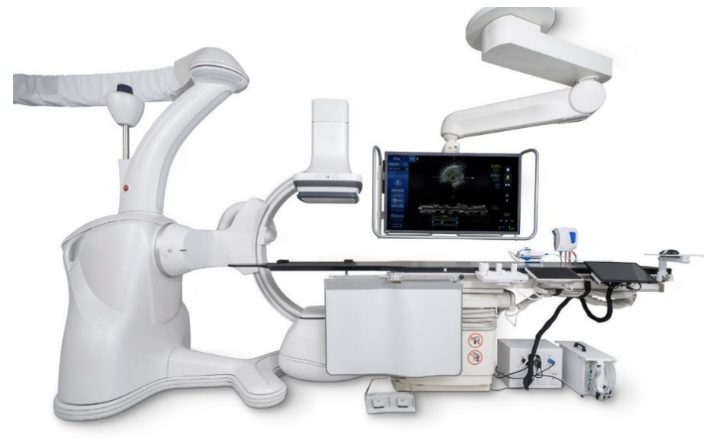By : Geraldus Sigap
The aorta is the body’s largest artery, carrying oxygen-rich blood from the heart to the rest of the body. Because of its critical role, any disease or abnormality in the aorta can lead to severe health complications, including aneurysms, blockages, and tears in the artery walls. Advances in medical imaging have significantly improved how doctors diagnose and treat aortic conditions, and one of the most innovative tools available today is Intravascular Ultrasound (IVUS).
IVUS is a cutting-edge imaging technology that allows doctors to see inside the arteries in real-time. Unlike traditional imaging techniques that rely on X-rays or CT scans, IVUS uses sound waves to create high-resolution, three-dimensional images of the aortic walls and blood flow patterns.

How IVUS Works and Why It Is Revolutionary
IVUS involves inserting a tiny ultrasound probe into the artery through a catheter, which is guided to the area of interest. The device emits high-frequency sound waves, which bounce off the artery walls and surrounding tissues. These echoes are then converted into detailed cross-sectional images, allowing doctors to assess the structure, thickness, and health of the arterial walls.
Key Benefits of IVUS in Aortic Procedures
The ability to see inside the arteries with such clarity has revolutionized aortic procedures in several ways:
- More Accurate Diagnosis of Aortic Diseases
Many aortic conditions, such as aneurysms, dissections, and atherosclerosis, can be challenging to detect using conventional imaging methods. IVUS allows doctors to directly measure arterial wall thickness, detect plaque buildup, and identify abnormal tissue inside the aorta. This enables earlier and more precise diagnosis, leading to timely and targeted treatments.
- Improved Stent Placement for Aortic Aneurysms
Patients with aortic aneurysms, where a weakened section of the artery bulges and may rupture, often require stent grafts to reinforce the aorta. IVUS helps guide the precise placement of these stents, ensuring they are positioned correctly and fully expanded. This reduces the risk of complications, such as endoleaks, where blood leaks around the stent, potentially leading to further problems.
- Enhanced Detection and Treatment of Aortic Blockages
Atherosclerosis, a condition where plaque builds up inside the arteries, can narrow the aorta and restrict blood flow. IVUS helps doctors assess the severity of these blockages and determine whether treatments like angioplasty or stenting are necessary. The technology provides clear images of plaque composition, distinguishing between soft, high-risk plaques and harder, calcified ones. This helps in making more informed treatment decisions and reducing the risk of future heart attacks or strokes.
- Increased Safety and Precision in Minimally Invasive Procedures
IVUS is commonly used in endovascular aortic repair (EVAR), a minimally invasive procedure for treating aortic aneurysms. Because precise placement of devices is crucial, IVUS ensures that catheters, balloons, and stents are guided accurately into position. This minimizes the risk of complications and reduces the need for repeated procedures.
- Reduced Radiation Exposure Compared to Traditional Imaging
Unlike fluoroscopy (X-ray imaging used during procedures), IVUS does not expose patients to ionizing radiation. This is particularly beneficial for individuals who require multiple aortic procedures or long-term monitoring, as it reduces their overall radiation exposure while still providing highly detailed images.
Who Can Benefit from IVUS?
IVUS is particularly useful for patients with:
- Aortic aneurysms – to guide stent placement and monitor artery walls
- Aortic dissections – to evaluate the severity of artery tears and guide treatment
- Atherosclerosis – to assess plaque buildup and determine treatment strategies
- Peripheral artery disease (PAD) – to check for blockages and aid in stent placement
- Previous aortic surgery or interventions – to ensure long-term monitoring of stents and grafts
Doctors often recommend IVUS for high-risk patients or those whose condition requires detailed assessment beyond what standard imaging can provide.
IVUS and the Future of Aortic Care
As medical technology continues to evolve, IVUS is becoming an essential tool in modern aortic procedures. It provides unmatched accuracy and safety, allowing doctors to detect problems earlier, treat conditions more effectively, and improve patient outcomes. Combined with robotic-assisted surgery and artificial intelligence (AI)-powered diagnostics, IVUS represents the future of minimally invasive cardiovascular care.
Many leading hospitals and heart centers now incorporate IVUS into routine aortic procedures, ensuring that patients receive the most precise and personalized care possible.
Advanced Cardiac and Vascular Care at RS Abdi Waluyo
RS Abdi Waluyo is committed to cutting-edge cardiovascular care, offering IVUS-guided procedures for the diagnosis and treatment of aortic diseases. With a team of experienced cardiologists and vascular specialists, the hospital provides advanced imaging and minimally invasive interventions for conditions such as aortic aneurysms, arterial blockages, and heart disease.
Resource :
- Belkin N, Jackson BM, Foley PJ, et al. The use of intravascular ultrasound in the treatment of type B aortic dissection with thoracic endovascular aneurysm repair is associated with improved long-term survival. J Vasc Surg 2020;72(2):490–497.
- Shimoda T, D’Oria M, Kuno T, et al. Comparative Effectiveness of Intravascular Ultrasound Versus Angiography in Abdominal and Thoracic Endovascular Aortic Repair: Systematic Review and Meta-Analysis. Am J Cardiol 2024;223:81–91.
- Mosarla RC, Heindel PV, Hussain MA, et al. Utilization and Outcomes Associated With Intravascular Ultrasound During Abdominal and Thoracic Endovascular Aortic Interventions in the United States in the Contemporary Era (2016–2023). Circ Cardiovasc Interv 2024;18(1):e014332.
